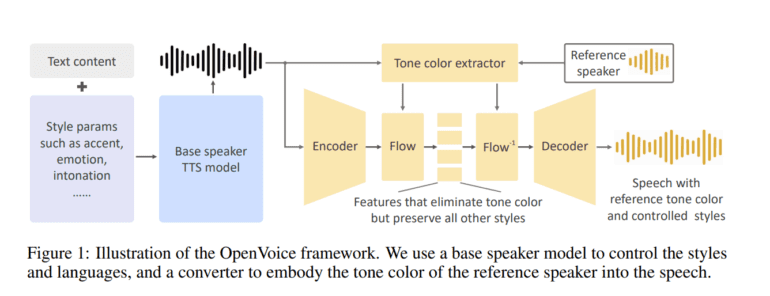TL;DR:
- OpenVoice, developed by MIT, MyShell.ai, and Tsinghua University, revolutionizes instant voice cloning.
- Challenges in voice cloning, such as flexible voice style control and cross-lingual cloning, are overcome.
- OpenVoice offers precise control over voice styles, including emotions, accents, and intonation.
- It achieves zero-shot cross-lingual cloning without extensive training data.
- The unique tone color cloning feature accurately replicates the reference speaker’s tonal nuances.
- OpenVoice is highly cost-efficient compared to commercial APIs.
Main AI News:
In the realm of voice cloning, two formidable challenges have long persisted. First, achieving flexible voice style control has been an elusive goal for many Instant Voice Cloning (IVC) methodologies. These approaches often struggle to manipulate voice styles with precision, encompassing elements such as emotions, accents, rhythm, pauses, intonation, and the nuanced tonal qualities of the original speaker. Second, the quest for Zero-Shot Cross-Lingual Voice Cloning has demanded colossal multi-lingual datasets, a hurdle that many IVC methods find insurmountable.
Enter OpenVoice, a groundbreaking open-source solution developed collaboratively by MIT, MyShell.ai, and Tsinghua University researchers. OpenVoice shatters the barriers of traditional voice cloning by empowering users to replicate voices and generate multilingual speech with nothing more than a brief audio snippet from the source speaker. This remarkable innovation extends its prowess to faithfully capturing the tonal nuances of the reference speaker, while also granting unprecedented control over critical style elements, including emotions, accents, rhythm, pauses, and intonation.
OpenVoice’s Key Features:
- Flexible Voice Style Control: OpenVoice introduces a novel approach to decoupling the components of a voice, allowing for independent adjustments in language, tone color, and other voice features. This innovation sets the stage for unparalleled flexibility in voice style manipulation.
- Zero-Shot Cross-Lingual Cloning: One of OpenVoice’s most remarkable achievements is its ability to clone voices for languages absent from the extensive training datasets used by traditional IVC methods. This zero-shot cross-lingual capability opens doors to a multitude of language possibilities.
- Tone Color Cloning: OpenVoice utilizes a unique tone color converter, inspired by flow-based Text-to-Speech (TTS) techniques, to faithfully replicate the tone color of the reference speaker. This is achieved with remarkable accuracy, even in cases where the reference speaker’s language or the generated speech is not represented in the training data.
- Efficiency Redefined: Unlike commercial APIs, OpenVoice boasts exceptional computational efficiency, significantly reducing the cost of voice cloning and making it accessible to a broader audience.
In essence, OpenVoice stands as a testament to the fusion of cutting-edge technology and unyielding innovation. Enabling granular control over voice styles empowers users to craft contextually authentic speech and dynamic conversations, steering clear of monotonous narrations. Furthermore, its ability to bridge language gaps and seamlessly clone voices across linguistic boundaries cements OpenVoice as a game-changer in the field of voice AI.
For those seeking a versatile, efficient, and precise instant voice cloning solution, OpenVoice emerges as the unrivaled choice, outperforming commercial APIs while upholding the highest standards of computational efficiency. It is poised to redefine the landscape of voice AI, offering a transformative tool for businesses and creators alike.
Conclusion:
OpenVoice’s innovative approach to instant voice cloning addresses long-standing challenges and reshapes the voice AI market. Its flexibility, precision, and efficiency position it as a game-changer, empowering businesses and creators to craft authentic multilingual voices with ease, ultimately disrupting the market by offering a superior alternative to existing solutions.

